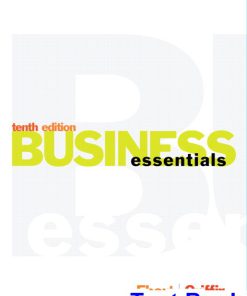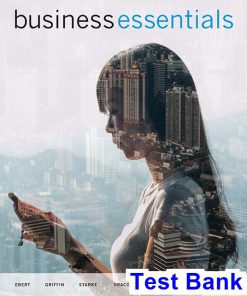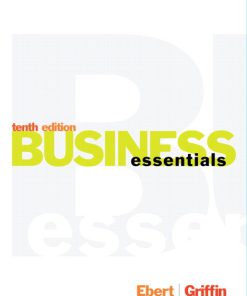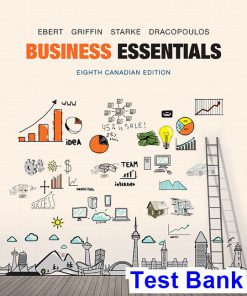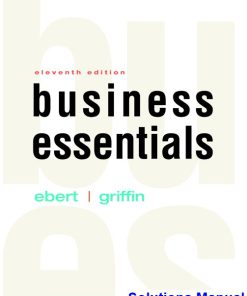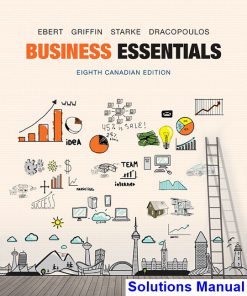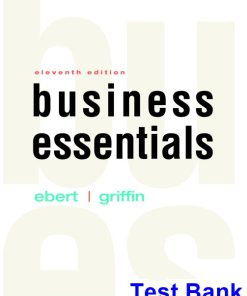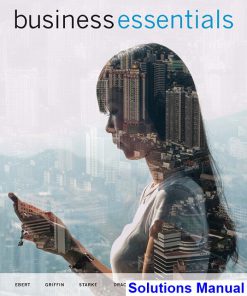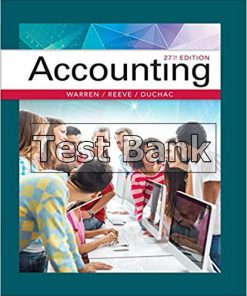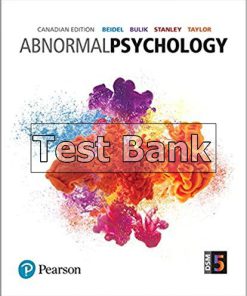Business Essentials 12th Edition Ebert Test Bank
$50.00 Original price was: $50.00.$26.50Current price is: $26.50.
Business Essentials 12th Edition Ebert Test Bank.
This is completed downloadable of Business Essentials 12th Edition Ebert Test Bank

Product Details:
- ISBN-10 : 0134728394
- ISBN-13 : 978-0134728391
- Author: Ronald Ebert (Author), Ricky Griffin (Author)
The recent events in domestic and global economies are presenting unprecedented challenges, excitement, and disappointments for businesses — and a need for change in introduction to business courses and texts. Business Essentials captures the widespread significance of these developments and presents their implications on companies today. The 12th Edition includes new real-world examples and research findings, helping students to see how entrepreneurs are putting into practice the concepts that they are learning about, and making this text the most current and relevant one available on the market.
Table of Content:
- Part 1 The Contemporary Business World
- Chapter 1 The U.S. Business Environment
- Learning Objectives
- Doing Business in the Global Marketplace
- Business, Profit, and the External Environment
- Business and Profit
- Consumer Choice and Demand
- Opportunity and Enterprise
- The Benefits of Business
- The External Environments of Business
- Domestic Business Environment
- Global Business Environment
- Technological Environment
- Political-Legal Environment
- Sociocultural Environment
- Economic Environment
- Economic Systems
- Factors of Production
- Labor
- Capital
- Entrepreneurs
- Physical Resources
- Information Resources
- Types of Economic Systems
- Planned Economies
- Market Economies
- Mixed Market Economies
- The Economics of Market Systems
- Demand and Supply in a Market Economy
- The Laws of Demand and Supply
- The Demand and Supply Schedule
- Demand and Supply Curves
- Surpluses and Shortages
- Private Enterprise and Competition in a Market Economy
- Degrees of Competition
- Perfect Competition
- Monopolistic Competition
- Oligopoly
- Monopoly
- Economic Indicators
- Economic Growth, Aggregate Output, and Standard of Living
- Gross Domestic Product
- Real Growth Rate
- GDP Per Capita
- REAL GDP
- Purchasing Power Parity
- Productivity
- Balance of Trade
- National Debt
- Economic Stability
- Inflation
- Unemployment
- Recessions and Depressions
- Managing the U.S. Economy
- Developing Skills in Your Career
- Summary of Learning Objectives
- Objective 1-1
- Objective 1-2
- Objective 1-3
- Objective 1-4
- Key Terms
- Questions & Exercises
- Questions For Review
- Questions for Analysis
- Application Exercises
- Building a Business: Continuing Team Exercise
- Assignment
- Team Exercise
- Competition in the New Mobile Economy
- Background Information
- Team Activity
- Follow-Up Questions
- Exercising your Ethics
- Getting Caught Out in The Cold
- The Situation
- The Dilemma
- Questions to Address
- Cases
- Doing Business in the Global Marketplace
- Questions for Discussion
- Game Theory in the Video Game Console Industry
- Questions for Discussion
- Endnotes
- Chapter 2 Understanding Business Ethics and Social Responsibility
- Learning Objectives
- Simply Divine
- Ethics in the Workplace
- Individual Ethics
- The Law and the Real World
- Individual Values and Morals
- Business and Managerial Ethics
- Behavior Toward Employees
- Behavior Toward the Organization
- Behavior Toward Other Economic Agents
- Assessing Ethical Behavior
- Company Practices and Business Ethics
- Adopting Written Codes
- Instituting Ethics Programs
- Social Responsibility
- The Stakeholder Model of Responsibility
- Customers
- Employees
- Investors
- Suppliers
- Local and International Communities
- Contemporary Social Consciousness
- Areas of Social Responsibility
- Responsibility Toward the Environment
- Air Pollution
- Water Pollution
- Land Pollution
- Toxic Waste Disposal
- Recycling
- Responsibility Toward Customers
- Consumer Rights
- Unfair Pricing
- Ethics in Advertising
- Responsibility Toward Employees
- Legal and Social Commitments
- Ethical Commitments: The Special Case of Whistle-Blowers
- Responsibility Toward Investors
- Insider Trading
- Misrepresentation of Finances
- Implementing Social Responsibility Programs
- Approaches to Social Responsibility
- Obstructionist Stance
- Defensive Stance
- Accommodative Stance
- Proactive Stance
- Social Responsibility and the Small Business
- The Government and Social Responsibility
- How Governments Influence Business
- Direct Regulation
- Indirect Regulation
- How Business Influences Government
- Personal Contacts
- Lobbying
- Political Action Committees
- Favors
- Managing Social Responsibility
- Formal Organizational Dimensions
- Legal Compliance
- Ethical Compliance
- Philanthropic Giving
- Informal Organizational Dimensions
- Organization Leadership and Culture
- Whistle-Blowing
- Evaluating Social Responsibility
- Summary of Learning Objectives
- Objective 2-1
- Objective 2-2
- Objective 2-3
- Objective 2-4
- Objective 2-5
- Objective 2-6
- Key Terms
- Questions & Exercises
- Questions For Review
- Questions for Analysis
- Application Exercises
- Building a Business: Continuing Team Exercise
- Assignment
- Team Exercise
- To Lie or Not To Lie: That is The Question
- Background Information
- Method
- Follow-Up Questions
- Exercising your Ethics
- The Case of Orphan Drugs
- The Situation
- The Dilemma
- Questions to Address
- Cases
- Simply Divine
- Questions for Discussion
- When Mother Nature Storms In
- Questions for Discussion
- Endnotes
- Chapter 3 Entrepreneurship, New Ventures, and Business Ownership
- Learning Objectives
- It All Started With a Late Fee
- What is a Small Business?
- The Importance of Small Business in the U.S. Economy
- Job Creation
- Innovation
- Contributions to Big Business
- Popular Areas of Small Business Enterprise
- Services
- Retailing
- Construction
- Wholesaling
- Finance and Insurance
- Manufacturing
- Transportation
- Other
- Entrepreneurship
- Entrepreneurship Goals
- Entrepreneurial Characteristics
- Starting and Operating a New Business
- Understanding Distinctive Competencies
- Identifying Niches in Established Markets
- Identifying New Markets
- First-Mover Advantages
- Crafting a Business Plan
- Setting Goals and Objectives
- Sales Forecasting
- Financial Planning
- Starting the Small Business
- Buying an Existing Business
- Franchising
- Starting from Scratch
- Financing the Small Business
- SBA Financial Programs
- Other Sources of Financing
- Trends, Successes, and Failures in New Ventures
- Trends in Small Business Start-Ups
- Emergence of E-Commerce
- Crossovers from Big Business
- Opportunities for Minorities and Women
- Global Opportunities
- Better Survival Rates
- Reasons for Failure
- Reasons for Success
- Noncorporate Business Ownership
- Sole Proprietorships
- Advantages of Sole Proprietorships
- Disadvantages of Sole Proprietorships
- Partnerships
- Advantages of Partnerships
- Disadvantages of Partnerships
- Alternatives to General Partnerships
- Cooperatives
- Corporations
- The Corporate Entity
- Advantages of Incorporation
- Disadvantages of Incorporation
- Types of Corporations
- Managing a Corporation
- Stock Ownership and Stockholders’ Rights
- Boards of Directors
- Officers
- Special Issues in Corporate Ownership
- Joint Ventures and Strategic Alliances
- Employee Stock Ownership Plans
- Institutional Ownership
- Mergers, Acquisitions, Divestitures, and Spin-Offs
- Mergers and Acquisitions (M&As)
- Divestitures and Spin-Offs
- Summary of Learning Objectives
- Objective 3-1
- Objective 3-2
- Objective 3-3
- Objective 3-4
- Objective 3-5
- Objective 3-6
- Key Terms
- Questions & Exercises
- Questions For Review
- Questions for Analysis
- Application Exercises
- Building a Business: Continuing Team Exercise
- Assignment
- Team Exercise
- A Tasty Idea
- Background Information
- Team Activity
- Follow-Up Questions
- Exercising your Ethics
- Breaking Up is Hard to Do
- The Situation
- The Dilemma
- Questions to Address
- Cases
- It All Started with a Late Fee
- Questions for Discussion
- Ice Cream Headache
- Questions for Discussion
- Endnotes
- Chapter 4 Understanding the Global Context of Business
- Learning Objectives
- The Door Opens
- The Contemporary Global Economy
- The Major World Marketplaces
- Distinctions Based on Wealth
- Geographic Clusters
- North America
- Europe
- Pacific Asia
- Trade Agreements and Alliances
- North American Free Trade Agreement
- The European Union
- The Association of Southeast Asian Nations
- The World Trade Organization
- International Trade
- Balance of Trade
- Balance of Payments
- Exchange Rates
- Forms of Competitive Advantage
- Absolute Advantage
- Comparative Advantage
- National Competitive Advantage
- International Business Management
- Going International
- Gauging International Demand
- Adapting to Customer Needs
- Outsourcing and Offshoring
- Levels of International Involvement
- Exporters and Importers
- International Firms
- Multinational Firms
- International Organization Structures
- Independent Agents
- Licensing Arrangements
- Branch Offices
- Strategic Alliances
- Foreign Direct Investment
- Understanding the Cultural Environment
- Values, Symbols, Beliefs, and Language
- Employee Behavior Across Cultures
- Barriers to International Trade
- Economic Differences
- Legal and Political Differences
- Quotas, Tariffs, and Subsidies
- The Protectionism Debate
- Local Content Laws
- Business Practice Laws
- Summary of Learning Objectives
- Objective 4-1
- Objective 4-2
- Objective 4-3
- Objective 4-4
- Objective 4-5
- Key Terms
- Questions & Exercises
- Questions For Review
- Questions for Analysis
- Application Exercises
- Building a Business: Continuing Team Exercise
- Assignment
- Team Exercise
- Weighing the Trade-Offs
- The Situation
- The Dilemma
- Team Activity
- Exercising your Ethics
- Paying Heed to Foreign Practices
- The Situation
- The Dilemma
- Questions to Address
- Cases
- The Door Opens
- Questions for Discussion
- Not My Cup of Tea
- Questions for Discussion
- Crafting a Business Plan
- Part 1: The Contemporary Business Environment
- Goal of the Exercise
- Exercise Background: Part 1 of the Business Plan
- Your Assignment
- Endnotes
- Part 2 Managing the Business
- Chapter 5 Managing the Business
- Learning Objectives
- Alphabet Soup
- The Management Process
- Basic Management Functions
- Planning
- Organizing
- Leading
- Controlling
- The Science and the Art of Management
- The Science of Management
- The Art of Management
- Becoming a Manager
- The Role of Education
- The Role of Experience
- Types of Managers
- Levels of Management
- Top Managers
- Middle Managers
- First-Line Managers
- Areas of Management
- Human Resource Managers
- Operations Managers
- Marketing Managers
- Information Managers
- Financial Managers
- Other Managers
- Management Roles and Skills
- Managerial Roles
- Interpersonal Roles
- Informational Roles
- Decisional Roles
- Basic Management Skills
- Technical Skills
- Human Relations Skills
- Conceptual Skills
- Decision-Making Skills
- Time Management Skills
- Global Management Skills
- Management and Technology Skills
- Strategic Management: Setting Goals and Formulating Strategy
- Setting Business Goals
- Purposes of Goal Setting
- Kinds of Goals
- Types of Strategy
- Corporate Strategy
- Business (or Competitive) Strategy
- Functional Strategy
- Formulating Strategy
- A Hierarchy of Plans
- Contingency Planning and Crisis Management
- Contingency Planning
- Crisis Management
- Management and the Corporate Culture
- Building and Communicating Culture
- Changing Culture
- Summary of Learning Objectives
- Objective 5-1
- Objective 5-2
- Objective 5-3
- Objective 5-4
- Objective 5-5
- Objective 5-6
- Key Terms
- Questions & Exercises
- Questions For Review
- Questions for Analysis
- Application Exercises
- Building a Business: Continuing Team Exercise
- Assignment
- Team Exercise
- Dreams can Come True
- The Situation
- Team Activity
- Action Steps
- Exercising your Ethics
- Time for the AX?
- The Situation
- The Dilemma
- Questions to Address
- Cases
- Alphabet Soup
- Questions for Discussion
- When Old Is New and New Is Old
- Questions for Discussion
- Endnotes
- Chapter 6 Organizing the Business
- Learning Objectives
- Organizing for Success
- What Is Organizational Structure?
- Organization Charts
- Determinants of Organizational Structure
- The Building Blocks of Organizational Structure
- Job Specialization
- Departmentalization
- Functional Departmentalization
- Product Departmentalization
- Process Departmentalization
- Customer Departmentalization
- Geographic Departmentalization
- Multiple Forms of Departmentalization
- Establishing the Decision-Making Hierarchy
- Distributing Authority: Centralization and Decentralization
- Centralized Organizations
- Decentralized Organizations
- Tall and Flat Organizations
- Span of Control
- The Delegation Process
- Three Forms of Authority
- Line Authority
- Staff Authority
- Committee and Team Authority
- Basic Forms of Organizational Structure
- Functional Structure
- Divisional Structure
- Matrix Structure
- International Structure
- New Forms of Organizational Structure
- Team Organization
- Virtual Organization
- Learning Organization
- Informal Organization
- Informal Groups
- Organizational Grapevine
- Intrapreneuring
- Summary of Learning Objectives
- Objective 6-1
- Objective 6-2
- Objective 6-3
- Objective 6-4
- Objective 6-5
- Key Terms
- Questions & Exercises
- Questions For Review
- Questions for Analysis
- Application Exercises
- Building a Business: Continuing Team Exercise
- Assignment
- Team Exercise
- Getting with the Program
- Background Information
- Method
- Follow-Up Questions
- Exercising your Ethics
- I Heard it Through the Grapevine
- The Situation
- The Dilemma
- Questions to Address
- Cases
- Pushing the Product
- Questions for Discussion
- Heard it Through the Grapevine
- Questions for Discussion
- Endnotes
- Chapter 7 Operations Management and Quality
- Learning Objectives
- Dessert Is Always a Great Idea
- What Does Operations Mean Today?
- Growth in the Services and Goods Sectors
- Creating Value Through Operations
- Differences between Service and Goods Manufacturing Operations
- Interacting with Customers
- Services Can Be Intangible and Unstorable
- Customers’ Presence in the Operations Process
- Intangibles Count for Service Quality
- Operations Processes
- Goods Production Processes: Make-to-Order versus Make-to-Stock Processes
- Service Production Processes: Extent of Customer Contact
- Low-Contact Systems
- High-Contact Systems
- Business Strategy as the Driver of Operations
- The Many Faces of Production Operations
- Business Strategy Determines Operations Capabilities
- Expanding into Additional Capabilities
- Operations Planning
- Capacity Planning
- Location Planning
- Layout Planning
- Process Layouts
- Product Layouts
- Fixed Position Layouts
- Quality Planning
- Methods Planning
- Improving Process Flows
- Improving Customer Service
- Operations Scheduling
- The Master Operations Schedule
- Detailed Schedules
- Staff Schedules and Computer-Based Scheduling
- Project Scheduling
- The Gantt Graphical Method
- Project Scheduling with PERT Charts
- Operations Control
- Materials Management
- Materials Management Activities for Physical Goods
- Lean Production Systems
- Inventory Management Is Crucial for Producing Services
- Quality Control
- Quality Improvement and Total Quality Management
- The Quality-Productivity Connection
- Managing for Quality
- The Cost of Poor Quality
- Quality Ownership: Taking Responsibility for Quality
- Tools for Total Quality Management
- Value-Added Analysis
- Quality Improvement Teams
- Getting Closer to the Customer
- Identifying Customers—Internal and External
- The ISO Series
- ISO 9000
- ISO 14000
- Business Process Reengineering
- Adding Value Through Supply Chains
- The Supply Chain Strategy
- Supply Chain Management
- Reengineering Supply Chains for Better Results
- Outsourcing and Global Supply Chains
- Summary of Learning Objectives
- Objective 7-1
- Objective 7-2
- Objective 7-3
- Objective 7-4
- Objective 7-5
- Objective 7-6
- Objective 7-7
- Objective 7-8
- Key Terms
- Questions & Exercises
- Questions For Review
- Questions for Analysis
- Application Exercises
- Building a Business: Continuing Team Exercise
- Assignment
- Team Exercise
- Calculating the Cost of Conscience
- The Situation
- The Decision
- Follow-Up Questions
- Exercising your Ethics
- Promises, Promises
- The Situation
- The Dilemma
- Questions to Address
- Cases
- Dessert Is Always a Great Idea
- Questions for Discussion
- Telecommuting Boosts Quality and Productivity … Or Does It?
- Questions for Discussion
- Crafting a Business Plan
- Part 2: The Business of Managing
- Goal of the Exercise
- Exercise Background: Part 2 of the Business Plan
- Your Assignment
- Endnotes
- Part 3 People in Organizations
- Chapter 8 Employee Behavior and Motivation
- Learning Objectives
- A Living Wage
- Forms of Employee Behavior
- Performance Behaviors
- Organizational Citizenship
- Counterproductive Behaviors
- Individual Differences Among Employees
- Personality at Work
- The “Big Five” Personality Traits
- The Myers-Briggs Framework
- Emotional Intelligence
- Other Personality Traits at Work
- Attitudes at Work
- How Attitudes Are Formed
- Attitude Structure
- Cognitive Dissonance
- Key Work-Related Attitudes
- Matching People and Jobs
- Psychological Contracts
- The Person-Job Fit
- Basic Motivation Concepts and Theories
- Classical Theory
- Early Behavioral Theory
- Human Resources Model: Theories X and Y
- Maslow’s Hierarchy of Needs Model
- Two-Factor Theory
- Other Important Needs
- Contemporary Motivation Theory
- Expectancy Theory
- Equity Theory
- Strategies and Techniques for Enhancing Motivation
- Reinforcement/Behavior Modification
- Using Goals to Motivate Behavior
- Participative Management and Empowerment
- Work Teams and Team Structures
- Job Enrichment and Job Redesign
- Job Enrichment Programs
- Job Redesign Programs
- Combining Tasks
- Forming Natural Work Groups
- Establishing Client Relationships
- Modified Work Schedules and Alternative Workplaces
- Work-Share Programs
- Flextime Programs
- Alternative Workplaces
- Advantages and Disadvantages of Modified Schedules and Alternative Workplaces
- Summary of Learning Objectives
- Objective 8-1
- Objective 8-2
- Objective 8-3
- Objective 8-4
- Objective 8-5
- Key Terms
- Questions & Exercises
- Questions For Review
- Questions for Analysis
- Application Exercises
- Building a Business: Continuing Team Exercise
- Assignment
- Team Exercise
- Too Much of a Good Thing
- The Situation
- Method
- Exercising your Ethics
- Too Much of a Good Thing
- The Situation
- The Dilemma
- Questions to Address
- Cases
- A Living Wage
- Questions for Discussion
- Searching for a Great Place to Work
- Questions for Discussion
- Endnotes
- Chapter 9 Leadership and Decision Making
- Learning Objectives
- Authentic Leadership
- The Nature of Leadership
- Leadership and Management
- Leadership and Power
- Early Approaches to Leadership
- Trait Approaches to Leadership
- Behavioral Approaches to Leadership
- The Situational Approach to Leadership
- Leadership Through the Eyes of Followers
- Transformational Leadership
- Charismatic Leadership
- Special Issues in Leadership
- Leadership Substitutes
- Leadership Neutralizers
- The Changing Nature of Leadership
- Leaders as Coaches
- Gender and Leadership
- Cross-Cultural Leadership
- Emerging Issues in Leadership
- Strategic Leadership
- Ethical Leadership
- Virtual Leadership
- Leadership, Management, and Decision Making
- The Nature of Decision Making
- Types of Decisions
- Decision-Making Conditions
- Certainty
- Risk
- Uncertainty
- Rational Decision Making
- Recognizing and Defining the Decision Situation
- Identifying Alternatives
- Evaluating Alternatives
- Selecting the Best Alternative
- Implementing the Chosen Alternative
- Following Up and Evaluating the Results
- Behavioral Aspects of Decision Making
- Political Forces in Decision Making
- Intuition
- Escalation of Commitment
- Risk Propensity and Decision Making
- Summary of Learning Objectives
- Objective 9-1
- Objective 9-2
- Objective 9-3
- Objective 9-4
- Objective 9-5
- Objective 9-6
- Objective 9-7
- Objective 9-8
- Key Terms
- Questions & Exercises
- Questions For Review
- Questions for Analysis
- Application Exercises
- Building a Business: Continuing Team Exercise
- Assignment
- Team Exercise
- Managing Changes in Strategic Direction
- The Situation
- Team Activity
- Action Steps
- Exercising your Ethics
- Exercising Charisma
- The Situation
- The Dilemma
- Questions to Address
- Cases
- Authentic Leadership
- Questions for Discussion
- The Man Behind the Genius
- Questions for Discussion
- Endnotes
- Chapter 10 Human Resource Management and Labor Relations
- Learning Objectives
- A Unique Partnership Drives Wegmans
- The Foundations of Human Resource Management
- The Strategic Importance of HRM
- HR Planning
- Job Analysis
- Forecasting HR Demand and Supply
- Replacement Charts
- Skills Inventories
- Matching HR Supply and Demand
- The Legal Context of HRM
- Equal Employment Opportunity
- Compensation and Benefits
- Labor Relations
- Health and Safety
- Other Legal Issues
- AIDS in the Workplace
- Sexual Harassment
- Employment at Will
- The Patriot Act
- Staffing the Organization
- Recruiting Employees
- Internal Recruiting
- External Recruiting
- Selecting Employees
- Application Forms
- Tests
- Interviews
- Other Techniques
- Compensation and Benefits
- Wages and Salaries
- Incentive Programs
- Companywide Incentives
- Benefits Programs
- Retirement Plans
- Containing the Costs of Benefits
- Developing the Workforce
- Training and Development
- Assessing Training Needs
- Common Training Methods
- Evaluation of Training
- Performance Appraisal
- Common Appraisal Methods
- Errors in Performance Appraisal
- Performance Feedback
- New Challenges in the Changing Workplace
- Managing Workforce Diversity
- Managing Knowledge Workers
- Contingent and Temporary Workers
- Trends in Contingent and Temporary Employment
- Managing Contingent and Temporary Workers
- Dealing with Organized Labor
- Unionism Today
- The Future of Unions
- Collective Bargaining
- Reaching Agreement on Contract Terms
- Contract Issues
- Compensation
- Benefits
- Job Security
- When Bargaining Fails
- Union Tactics
- Management Tactics
- Mediation and Arbitration
- Summary of Learning Objectives
- Objective 10-1
- Objective 10-2
- Objective 10-3
- Objective 10-4
- Objective 10-5
- Objective 10-6
- Objective 10-7
- Key Terms
- Questions & Exercises
- Questions For Review
- Questions for Analysis
- Application Exercises
- Building a Business: Continuing Team Exercise
- Assignment
- Team Exercise
- The Downside of Downsizing
- The Situation
- Team Activity
- Action Steps
- Exercising your Ethics
- Operating Tactically
- The Situation
- The Dilemma
- Questions to Address
- Cases
- A Unique Partnership Drives Wegmans
- Questions for Discussion
- Finding the Work/Life Balance
- Questions for Discussion
- Crafting a Business Plan
- Part 3: People in Organizations
- Goal of the Exercise
- Exercise Background: Part 3 of the Business Plan
- Your Assignment
- Endnotes
- Part 4 Principles of Marketing: Building Relationships with Customers for Competitive Advantage
- Chapter 11 Marketing Processes and Consumer Behavior
- Learning Objectives
- Building a Brand With Social Media
- What Is Marketing?
- Delivering Value
- Value and Benefits
- Value and Utility
- Goods, Services, and Ideas
- Relationship Marketing and Customer Relationship Management
- The Marketing Environment
- Political-Legal Environment
- Sociocultural Environment
- Technological Environment
- Economic Environment
- Competitive Environment
- Developing the Marketing Plan
- Marketing Strategy: Planning the Marketing Mix
- Product
- Pricing
- Place (Distribution)
- Promotion
- Advertising
- Personal Selling
- Sales Promotions
- Public Relations
- Blending It All Together: Integrated Strategy
- Marketing Strategy: Target Marketing and Market Segmentation
- Identifying Market Segments
- Geographic Segmentation
- Demographic Segmentation
- Geo-Demographic Segmentation
- Psychographic Segmentation
- Behavioral Segmentation
- Marketing Research
- The Research Process
- Research Methods
- Understanding Consumer Behavior
- Influences on Consumer Behavior
- The Consumer Buying Process
- Problem or Need Recognition
- Information Seeking
- Evaluation of Alternatives
- Purchase Decision
- Postpurchase Evaluation
- Organizational Marketing and Buying Behavior
- Business Marketing
- Services Market
- Industrial Market
- Reseller Market
- Government and Institutional Market
- B2B Buying Behavior
- Differences in Buyers
- Differences in the Buyer–Seller Relationship
- Social Media and Marketing
- Viral Marketing and Social Networking
- Web-Driven Revenue with Social Networking
- The International Marketing Mix
- International Products
- International Pricing
- International Distribution
- International Promotion
- Small Business and the Marketing Mix
- Small-Business Products
- Small-Business Pricing
- Small-Business Distribution
- Small-Business Promotion
- Summary of Learning Objectives
- Objective 11-1
- Objective 11-2
- Objective 11-3
- Objective 11-4
- Objective 11-5
- Objective 11-6
- Objective 11-7
- Key Terms
- Questions & Exercises
- Questions For Review
- Questions for Analysis
- Application Exercises
- Building a Business: Continuing Team Exercise
- Assignment
- Team Exercise
- Home Away from Home
- Team Activity
- Exercising your Ethics
- Weighing the Odds
- The Situation
- The Dilemma
- Questions to Address
- Cases
- Building a Brand with Social Media
- Questions for Discussion
- Where Has All the Middle Gone?
- Questions for Discussion
- Endnotes
- Chapter 12 Developing and Pricing Products
- Learning Objectives
- The Price of Free College
- What Is a Product?
- The Value Package
- Classifying Goods and Services
- Classifying Consumer Products
- Classifying Organizational Products
- The Product Mix
- Developing New Products
- The New Product Development Process
- Product Mortality Rates
- The Seven-Step Development Process
- Variations in the Process for Services
- Product Life Cycle
- Stages in the PLC
- Extending Product Life: An Alternative to New Products
- Identifying Products
- Branding Products
- Gaining Brand Awareness
- Product Placements
- Types of Brand Names
- National Brands
- Licensed Brands
- Private Brands
- Packaging Products
- Determining Prices
- Pricing to Meet Business Objectives
- Profit-Maximizing Objectives
- Market Share (Market Penetration) Objectives
- Pricing for E-Business Objectives
- Price-Setting Tools
- Cost-Oriented Pricing
- Breakeven Analysis: Cost-Volume-Profit Relationships
- Pricing Strategies and Tactics
- Pricing Strategies
- Pricing Existing Products
- Pricing New Products
- Fixed versus Dynamic Pricing for Online Business
- Bundling
- Pricing Tactics
- International Pricing
- Summary of Learning Objectives
- Objective 12-1
- Objective 12-2
- Objective 12-3
- Objective 12-4
- Objective 12-5
- Key Terms
- Questions & Exercises
- Questions For Review
- Questions for Analysis
- Application Exercises
- Building a Business: Continuing Team Exercise
- Assignment
- Team Exercise
- The Price is Right
- Team Activity
- Exercising your Ethics
- Driving a Legitimate Bargain
- The Situation
- The Dilemma
- Questions to Address
- Cases
- Singing a Different Tune
- Changing Pricing Tactics Can Cost a Pretty Penney
- Questions for Discussion
- Endnotes
- Chapter 13 Distributing and Promoting Products
- Learning Objectives
- The Changing Landscape of Commerce
- The Distribution Mix
- Intermediaries and Distribution Channels
- Distribution of Goods and Services
- Channel 1: Direct Distribution
- Channel 2: Retail Distribution
- Channel 3: Wholesale Distribution
- Channel 4: Distribution by Agents or Brokers
- The Pros and Cons of Nondirect Distribution
- Distribution Strategies
- Channel Conflict and Channel Leadership
- Channel Conflict
- Channel Leadership
- Wholesaling
- Merchant Wholesalers
- Agents and Brokers
- The E-Intermediary
- Syndicated Sellers
- Shopping Agents
- Business-to-Business Brokers
- Retailing
- Types of Brick-and-Mortar Retail Outlets
- Product-Line Retailers
- Bargain Retailers
- Convenience Stores
- Nonstore Retailing
- Online Retailing
- Electronic Catalogs
- Electronic Storefronts and Cybermalls
- Interactive and Video Retailing
- Physical Distribution
- Warehousing Operations
- Transportation Operations
- Distribution Through Supply Chains as a Marketing Strategy
- The Importance of Promotion
- Promotional Objectives
- Promotional Strategies
- The Promotional Mix
- Advertising
- Advertising Media
- Real-Time Ad Tracking
- Personal Selling
- Personal Selling Situations
- Personal Selling Tasks
- The Personal Selling Process
- Sales Promotions
- Direct (or Interactive) Marketing
- Publicity and Public Relations
- Summary of Learning Objectives
- Objective 13-1
- Objective 13-2
- Objective 13-3
- Objective 13-4
- Objective 13-5
- Objective 13-6
- Key Terms
- Questions & Exercises
- Questions For Review
- Questions for Analysis
- Application Exercises
- Building a Business: Continuing Team Exercise
- Assignment
- Team Exercise
- Making a Difference
- Team Activity
- Action Steps
- Exercising your Ethics
- The Chain of Responsibility
- The Dilemma
- Questions to Address
- Cases
- The Changing Landscape of Commerce
- Questions for Discussion
- The Long Tail, Revisited
- Questions for Discussion
- Crafting a Business Plan
- Part 4: Principles of Marketing
- Goal of the Exercise
- Exercise Background: Part 4 of the Business Plan
- Your Assignment
- Endnotes
- Part 5 Managing Information for Better Business Decisions
- Chapter 14 Information Technology (IT) for Business
- Learning Objectives
- Think Before You Click
- Information Technology Impacts: A Driver of Changes for Business
- Creating Portable Offices: Providing Remote Access to Instant Information
- Enabling Better Service by Coordinating Remote Deliveries
- Creating Leaner, More Efficient Organizations
- Enabling Increased Collaboration
- Enabling Global Exchange
- Improving Management Processes
- Providing Flexibility for Customization
- Providing New Business Opportunities
- Improving the World and Our Lives
- IT Building Blocks: Business Resources
- The Internet and Other Communication Resources
- Intranets
- Extranets
- Electronic Conferencing
- VSAT Satellite Communications
- Networks: System Architecture
- Wide Area Networks (WANs)
- Local Area Networks (LANs)
- Wireless Networks
- Wi-Fi
- Hardware and Software
- Information Systems: Harnessing the Competitive Power of It
- Leveraging Information Resources: Data Warehousing and Data Mining
- Data Mining
- Information Linkages with Suppliers
- Types of Information Systems
- Information Systems for Knowledge Workers
- Information Systems for Managers
- Management Information Systems
- Decision Support Systems
- IT Risks and Threats
- Hackers
- Identity Theft
- Intellectual Property Theft
- Computer Viruses, Worms, and Trojan Horses
- Spyware
- Spam
- IT Protection Measures
- Preventing Unauthorized Access: Firewalls
- Preventing Identity Theft
- Preventing Infectious Intrusions: Anti-Virus Software
- Protecting Electronic Communications: Encryption Software
- Avoiding Spam and Spyware
- Ethical Concerns in IT
- Summary of Learning Objectives
- Objective 14-1
- Objective 14-2
- Objective 14-3
- Objective 14-4
- Objective 14-5
- Key Terms
- Questions & Exercises
- Questions For Review
- Questions for Analysis
- Application Exercises
- Building a Business: Continuing Team Exercise
- Assignment
- Team Exercise
- New Age Help Desk
- The Situation
- Questions for Discussion
- Exercising your Ethics
- To Read or Not to Read
- The Situation
- The Dilemma
- Questions to Address
- Cases
- Think Before You Click
- Questions for Discussion
- Selling Customer Search Data
- Questions for Discussion
- Endnotes
- Chapter 15 The Role of Accountants and Accounting Information
- Learning Objectives
- CSI: Wall Street
- What Is Accounting, and Who Uses Accounting Information?
- Financial versus Managerial Accounting
- Financial Accounting
- Managerial Accounting
- Certified Public Accountants
- The “Big Four” Public Accounting Firms
- CPA Services
- Auditing
- Tax Services
- Management Advisory Services
- Noncertified Public Accountants
- The CPA Vision Project
- Private Accountants and Management Accountants
- Forensic Accountants
- Investigative Accounting
- Litigation Support
- Certified Fraud Examiners
- Federal Restrictions on CPA Services and Financial Reporting: Sarbox
- The Accounting Equation
- Assets and Liabilities
- Owners’ Equity
- Financial Statements
- Balance Sheets
- Assets
- Current Assets
- Fixed Assets
- Intangible Assets
- Liabilities
- Owners’ Equity
- Income Statements
- Revenues
- Cost of Revenues (Cost of Goods Sold)
- Gross Profit
- Operating Expenses
- Operating and Net Income
- Statements of Cash Flows
- The Budget: An Internal Financial Statement
- Reporting Standards and Practices
- Revenue Recognition and Activity Timing
- Full Disclosure
- Analyzing Financial Statements
- Solvency Ratios: Borrower’s Ability to Repay Debt
- The Current Ratio and Short-Term Solvency
- Long-Term Solvency
- Profitability Ratios: Earnings Power for Owners
- Activity Ratios: How Efficiently Is the Firm Using Its Resources?
- Bringing Ethics into the Accounting Equation
- AICPA’s Code of Professional Conduct
- Violations of Accounting Ethics and GAAP
- Internationalizing Accounting
- International Accounting Standards Board
- Why One Set of Global Practices?
- Example Areas Targeted for Aligning U.S. GAAP and IASB
- Timetable for Implementation
- Summary of Learning Objectives
- Objective 15-1
- Objective 15-2
- Objective 15-3
- Objective 15-4
- Objective 15-5
- Objective 15-6
- Objective 15-7
- Key Terms
- Questions & Exercises
- Questions For Review
- Questions for Analysis
- Application Exercises
- Building a Business: Continuing Team Exercise
- Assignment
- Team Exercise
- An American Legend
- Questions for Discussion
- Exercising your Ethics
- Give and Take with Accounting Clients
- The Situation
- The Dilemma
- Questions to Address
- Cases
- CSI: Wall Street
- Questions for Discussion
- Future Directions for the Modern Accountant
- Questions for Discussion
- Crafting a Business Plan
- Part 5: Managing Information
- Goal of the Exercise
- Exercise Background: Part 5 of the Business Plan
- Your Assignment
- Endnotes
- Part 6 The Financial System and Issues in Financial Management
- Chapter 16 Understanding Money and the Role of Banking
- Learning Objectives
- Where Did All the Money Go?
- What Is Money?
- The Characteristics of Money
- The Functions of Money
- M-1: The Spendable Money Supply
- M-2: M-1 Plus the Convertible Money Supply
- Credit Cards and Debit Cards: Plastic Money?
- The U.S. Financial System
- Financial Institutions
- Commercial Banks
- Savings Institutions
- Savings and Loan Associations
- Mutual Savings Banks
- Credit Unions
- Nondeposit Institutions
- The Growth of Financial Services
- Pension and Trust Services
- International Services
- Financial Advice and Brokerage Services
- Electronic Funds Transfer
- How Financial Institutions Create Money and Are Regulated
- How Money Is Created
- How Banks Are Regulated
- The Federal Reserve System
- The Structure of the Fed
- The Board of Governors
- Reserve Banks
- Open Market Committee
- Member Banks
- Other Depository Institutions
- The Functions of the Fed
- The Government’s Bank
- The Bankers’ Bank
- Check Clearing
- Controlling the Money Supply
- The Tools of the Fed
- Reserve Requirements
- Interest Rate Controls
- Open-Market Operations
- The Changing Money and Banking System
- Government Intervention for Stabilizing the U.S. Financial System
- Government Emergency Investment
- Assurances of Repayment
- Anticrime and Antiterrorism Regulations
- The Impact of Electronic Technologies
- Automated Clearing House (ACH) Network
- Check 21: Making the Paper Check Go Away
- Blink Credit Card
- Debit Cards
- Smart Cards
- International Banking and Finance
- Currency Values and Exchange Rates
- Strong Currency or Weak: Which Is Better?
- Bank Policies Influence Currency Values
- The International Payments Process
- International Bank Structure
- Summary of Learning Objectives
- Objective 16-1
- Objective 16-2
- Objective 16-3
- Objective 16-4
- Objective 16-5
- Objective 16-6
- Key Terms
- Questions & Exercises
- Questions For Review
- Questions for Analysis
- Application Exercises
- Building a Business: Continuing Team Exercise
- Assignment
- Team Exercise
- Virtual Banking: An Idea Whose Time has Come?
- The Situation
- The Dilemma
- Team Activity
- Action Steps
- Exercising your Ethics
- Telling The Ethical From The Strictly Legal
- The Situation
- The Dilemma
- Questions to Address
- Cases
- Where Did All the Money GO?
- Global Trading Partner Resets Its Economic Compass
- Questions for Discussion
- Endnotes
- Chapter 17 Managing Business Finances
- Learning Objectives
- Fire On the Ground
- Maximizing Capital Growth
- The Time Value of Money and Compound Growth
- The Rule of 72
- Making Better Use of Your Time Value
- Common Stock Investments
- Investment Traits of Common Stock
- Dividends
- Investing to Fulfill Financial Objectives
- Reasons for Investing
- Most Mutual Funds Don’t Match the Market
- Exchange-Traded Funds
- The Business of Trading Securities
- Primary and Secondary Securities Markets
- Stock Exchanges
- The Trading Floor
- The Major Stock Exchanges
- The New York Stock Exchange
- Global Stock Exchanges
- The NASDAQ Market
- International Consolidation and Cross-Border Ownership
- Nonexchange Trading: Electronic Communication Networks
- Individual Investor Trading
- Stock Brokers
- Discount Brokers
- Full-Service Brokers
- Online Investing
- Tracking the Market Using Stock Indexes
- The Dow
- The S&P 500
- The NASDAQ Composite
- The Russell 2000
- Index-Matching ETFs
- The Risk–Return Relationship
- Investment Dividends (or Interest), Appreciation, and Total Return
- Dividends
- Price Appreciation
- Total Return
- Fantasy Stock Markets
- Managing Risk with Diversification and Asset Allocation
- Diversification
- Asset Allocation
- Performance Differences for Different Portfolios
- Financing the Business Firm
- Secured Loans for Equipment
- Working Capital and Unsecured Loans from Banks
- Angel Investors and Venture Capital
- Sale of Corporate Bonds
- Characteristics of Corporate Bonds
- Default and Bondholders’ Claim
- Risk Ratings
- Flawed Ratings Misread Recession Risks
- Becoming a Public Corporation
- Going Public Means Selling Part Ownership of the Company
- Stock Valuation
- Why Shares Are Different Prices
- Comparing Prices of Different Stocks
- Market Capitalization
- Choosing Equity versus Debt Capital
- Pros and Cons of Debt Financing
- Long-Term Loans
- Corporate Bonds
- Pros and Cons for Equity Financing
- The Expense of Common Stock
- Retained Earnings as a Source of Capital
- Regulating Securities Markets
- The Securities and Exchange Commission
- Regulations Against Insider Trading
- summary of learning objectives
- Objective 17-1
- Objective 17-2
- Objective 17-3
- Objective 17-4
- Objective 17-5
- Objective 17-6
- Objective 17-7
- Key Terms
- Questions & Exercises
- Questions For Review
- Questions for Analysis
- Application Exercises
- Building a Business: Continuing Team Exercise
- Assignment
- Team Exercise
- Market Ups and Downs
- Background Information
- Questions for Analysis
- Exercising your Ethics
- Are You Endowed with Good Judgment?
- The Situation
- The Dilemma
- Questions to Address
- Cases
- Fire On the Ground
- Time to Gogo?
- Questions for Discussion
- Crafting a Business Plan
- Part 6: Financial Issues
- Goal of the Exercise
- Exercise Background: Part 6 of the Business Plan
- Your Assignment
- Endnotes
- Appendix I Risk Management
- Coping with Risk
- Insurance as Risk Management
- Insurable Versus Uninsurable Risks
- Special Forms of Insurance for Business
- Liability Insurance
- Property Insurance
- Business Interruption Insurance
- Key Person Insurance
- Business Continuation Agreements
- Appendix II The Legal Context of Business
- The U.S. Legal and Judicial Systems
- Types of Law
- Common Law
- Statutory Law
- Regulatory Law
- Keeping an Eye on Business
- Trends in Deregulation and Regulation
- The U.S. Judicial System
- The Court System
- Trial Courts
- Appellate Courts
- Supreme Courts
- Business Law
- Contract Law
- Breach of Contract
- Tort Law
- Intentional Torts
- Negligence Torts
- Product Liability Torts
- Strict Product Liability
- Property Law
- Protection of Intellectual Rights
- Copyrights
- Trademarks
- Patents
- Restrictions on Property Rights
- Agency Law
- Authority of Agents
- Responsibilities of Principals
- Commercial Law
- Bankruptcy Law
- Business Bankruptcy
- The International Framework of Business Law
- Appendix III Managing Your Personal Finances
- Building Your Financial Plan
- Assessing Your Current Financial Condition
- Developing Your Financial Goals
- Making Better Use of the Time Value of Money
- Planning for the “Golden Years”
- Time Value as a Financial-Planning Tool
- Conserving Money by Controlling It
- Credit Cards: Keys to Satisfaction or Financial Handcuffs?
- Save Your Money: Lower Interest Rates and Faster Payments
- Seeking Lower Interest Rates
- Making Faster Payments
- Declining Asset Value: A Borrower’s Regret
- Financial Commitments of Home Ownership
- How Much House Can You Afford?
- PITI
- Other Debt
- Cashing Out from Tax Avoidance (Legally)
- The IRA Tax Break
- IRA Risks
- Roth IRA versus Traditional IRA
- IRAs and Education
- Protecting Your Net Worth
- Why Buy Life Insurance?
- What Does Life Insurance Do?
- How Much Should I Buy?
- Why Consider Term Insurance?
- How Much Does It Cost?
- Appendix IV Unions and Labor Management
- Why Do Workers Unionize?
- The Evolution of Unionism in the United States
- Early Unions
- The Emergence of the Major Unions
- The American Federation of Labor
- The Congress of Industrial Organizations
- The AFL-CIO
- Unionism Today
- Trends in Union Membership
- Composition of the Workforce
- Anti-Unionization Activities
- Trends in Union-Management Relations
- Trends in Bargaining Perspectives
- The Future of Unions
- Contemporary Union Structure
- Locals
- Laws Governing Labor-Management Relations
- The Major Labor Laws
- Norris-LaGuardia Act
- National Labor Relations (Wagner) Act
- Fair Labor Standards Act
- Taft-Hartley Act
- Unfair and Illegal Union Practices
- Injunctions and Cooling-Off Periods
- Enforced Resolution
- Landrum-Griffin Act
- How Unions Are Organized and Certified
- Collective Bargaining
- Reaching Agreement on Contract Terms
- Contract Issues
- Compensation
- Benefits
- Job Security
- Other Union Issues
- Management Rights
- When Bargaining Fails
- Union Tactics
- The Strike
- Other Labor Actions
- Management Tactics
- Mediation and Arbitration
- Administering a Labor Agreement
- Endnotes
- Glossary
- Index
People Also Search:
business essentials ebert
business essentials 12th edition ebert
business essentials
business essentials 12th edition
business essentials 12th edition testbank download pdf
business essentials 12th edition download scribd
Instant download after Payment is complete
You may also like…
Related products
Test Bank





